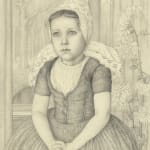Mies Elout-Drabbe (1875-1956)
Marie Jeanette Sophie Drabbe, known as Mies (or Moen) Drabbe, born in Utrecht in 1875, lived and worked mostly in Domburg. Encouraged by Toorop to pursue formal training, Drabbe studied at the Drawing Academy in The Hague from 1899 to 1901. In 1902, she married Paulus Johannes Elout van Soeterwoude and they had two children. It was in this artists’ colony in Zeeland where she organized summer exhibitions together with Jan Toorop between 1911 and 1921. Although she lived a relatively secluded life in Domburg, Drabbe became an important muse for visiting artists such as Toorop, Mondrian, and Richard Roland Holst.
Like many artists of the fin de siècle, Drabbe was searching for a higher spiritual reality and immersed herself in Eastern and Western philosophies, particularly theosophy and the teachings of the Neugeist movement. Her quest for a synthesis of pure representation of nature and the expression of the unseen forces behind visible reality shows her kinship with Toorop. Initially, Drabbe’s drawings closely followed Toorop’s examples of delicate portraits and paintings in luminist, pointillist, and symbolist styles. Until she met Mondrian. Briefly she explored more abstract and monumental concepts, but sensitive to the criticism of the time, retreated from this experimental course.
Provenance
Private collection, The NetherlandsVendu, Rotterdam, 11 November 2024, lot 334
Exhibitions
Amsterdam, Stedelijk Museum, 19de Jaarlijksche Tentoonstelling van Kunstwerken der Vereeniging St. Lucas, 11 April – 16 May 1909, no. 146Literature
Francisca van Vloten, Moen. Tussen Toorop en Mondriaan. De kunstenares Mies Elout-Drabbe 1875-1956, Vlissingen 2004, p. 41, ill.



